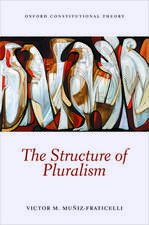The Ethics of Information Technologies
Editat de Keith W Miller, Mariarosaria Taddeoen Limba Engleză Hardback – 16 noi 2016
Preț: 1692.96 lei
Preț vechi: 2465.26 lei
-31% Nou
Puncte Express: 2539
Preț estimativ în valută:
323.94€ • 339.13$ • 268.04£
323.94€ • 339.13$ • 268.04£
Carte tipărită la comandă
Livrare economică 05-19 aprilie
Preluare comenzi: 021 569.72.76
Specificații
ISBN-13: 9781472431745
ISBN-10: 147243174X
Pagini: 504
Dimensiuni: 174 x 246 mm
Greutate: 1.02 kg
Ediția:1
Editura: Taylor & Francis
Colecția Routledge
Locul publicării:Oxford, United Kingdom
ISBN-10: 147243174X
Pagini: 504
Dimensiuni: 174 x 246 mm
Greutate: 1.02 kg
Ediția:1
Editura: Taylor & Francis
Colecția Routledge
Locul publicării:Oxford, United Kingdom
Cuprins
AcknowledgmentsSeries PrefaceIntroductionPart I: History and Theoretical Foundation of Information and Computer Ethics1 Moor, James H. (1985) “What is computer ethics?” Metaphilosophy 16.4: 266–752 Bynum, Terrell Ward, and Rogerson, Simon (1996) “Introduction and overview: Global information ethics.” Science and Engineering Ethics 2.2: 131–63 Tavani, Herman T. (2001) “The state of computer ethics as a philosophical field of inquiry: Some contemporary perspectives, future projections, and current resources.” Ethics and Information Technology 3.2: 97–1084 Bynum, Terrell W. (2010) “The historical roots of information and computer ethics,” in Luciano Floridi (ed.), The Cambridge Handbook of Information and Computer Ethics, Cambridge: Cambridge University Press, pp. 20–385 Floridi, Luciano (2013) “Distributed morality in an information society.” Science and Engineering Ethics 19.3: 727–43Part II: Ethics and Computer Artifacts6 Johnson, Deborah (2006) “Computer systems: Moral entities but not moral agents.” Ethics and Information Technology 8.4: 195–2047 Allen, Colin, Wallach, Wendell, and Smit, Iva (2006) “Why machine ethics?” Intelligent Systems IEEE 21.4: 12–17.8 Anderson, Michael, and Leigh Anderson, Susan (2007) “Machine ethics: Creating an ethical intelligent agent.” AI Magazine 28.4: 15–269 Grodzinsky, Frances S., Miller, Keith W., and Wolf, Marty J. (2008) “The ethics of designing artificial agents.” Ethics and Information Technology 10.2–3: 115–2110 Koscher, Karl, Czeskis, Alexei, Roesner, Franziska, Patel, Shwetak, Kohno, Tadayoshi, Checkoway, Stephen, McCoy, Damon, Kantor, Brian, Anderson, Danny, Shacham, Hovav, and Savage, Stefan (2010) “Experimental security analysis of a modern automobile.” 2010 IEEE Symposium on Security and Privacy, pp. 447–62, 16–19 May11 Ad Hoc Committee for Responsible Computing (2010) Moral Responsibility for Computing Artifacts: Five Rules, Version 27. https: / /edocs.uis.edu /kmill2 / www /TheRules /Part III: Computer Ethics, Privacy, and Anonymity12 Nissenbaum, Helen (1998) “Protecting privacy in an information age: The problem of privacy in public.” Law and Philosophy 17.5: 559–9613 Tavani, Herman T., and Grodzinsky, Frances S. (2002) “Cyberstalking, personal privacy, and moral responsibility.” Ethics and Information Technology 4.2: 123–3214 Yao-Huai, Lü (2005) “Privacy and data privacy issues in contemporary China.” Ethics and Information Technology 7.1: 7–1515 Van den Hoven, Jeroen, and Vermaas, Pieter E. (2007) “Nano-technology and privacy: On continuous surveillance outside the panopticon.” Journal of Medicine and Philosophy 32.3: 283–9716 Murata, Kiyoshi, and Orito, Yohko (2008) “Rethinking the concept of the right to information privacy: A Japanese perspective.” Journal of Information, Communication and Ethics in Society 6.3: 233–4517 Zimmer, Michael (2010) “‘But the data is already public’: On the ethics of research in Facebook.” Ethics and Information Technology 12.4: 313–2518 Serracino-Inglott, Philip (2013) “Is it OK to be an Anonymous?” Ethics & Global Politics 6.4: 217–44Part IV: Well-Being and the Ethics of Technology Design19 Weckert, John (2002) “Lilliputian computer ethics.” Metaphilosophy 33.3: 366–7520 Reynolds, Carson, and Picard, Rosalind (2004). “Ethical evaluation of displays that adapt to affect.” CyberPsychology and Behavior 7.6: 662–621 Friedman, Batya, Kahn, Peter H. Jr., and Borning, Alan (2006) “Value sensitive design and information systems,” in P. Zhang and D. Galletta (eds), Human-Computer Interaction in Management Information Systems: Foundations, Armonk, NY: M. E. Sharpe, pp. 348–7222 Turilli, Matteo (2007) “Ethical protocols design.” Ethics and Information Technology 9.1: 49–6223 Van den Hoven, Jeroen, and Manders-Huits, Noemi (2009) “Value-sensitive design,” in J. K. B. Olsen, S. A. Pedersen, and V. F. Hendricks (eds), A Companion to the Philosophy of Technology, Oxford: Wiley-Blackwell, pp. 477–80Part V: Education and Professional Ethics24 Gotterbarn, Donald (1992) “The use and abuse of computer ethics.” Journal of Systems and Software 17.1: 75–8025 Anderson, Ronald E., Johnson, Deborah G., Gotterbarn, Donald, and Perrolle, Judith (1993) “Using the new ACM code of ethics in decision making.” Communications of the ACM 36.2: 98–10726 Nissenbaum, Helen (1994) “Computing and accountability.” Communications of the ACM 37.1: 73–8027 Collins, W. R., Miller, K. W., Spielman, B. J., and Wherry, P. (1994) “How good is good enough? An ethical analysis of software construction and use.” Communications of the ACM 37.1: 81–9128 Martin, C. Dianne, and Weltz, Elaine Yale (1999) “From awareness to action: Integrating ethics and social responsibility into the computer science curriculum.” ACM SIGCAS Computers and Society 29.2: 6–1429 Trauth, Eileen M. (2002) “Odd girl out: An individual differences perspective on women in the IT profession.” Information Technology & People 15.2: 98–118Part VI: Social Interactions and Computer Games30 Brey, Philip (1999) “The ethics of representation and action in virtual reality.” Ethics and Information Technology 1.1: 5–1431 Ess, Charles, and Sudweeks, Fay (2005) “Culture and computer-mediated communication: Toward new understandings.” Journal of Computer- Mediated Communication 11.1: 179–9132 Sicart, Miguel (2005) “Game, player, ethics: A virtue ethics approach to computer games.” International Review of Information Ethics 4.12: 13–1833 Himma, Kenneth Einar (2007) “The concept of information overload: A preliminary step in understanding the nature of a harmful informationrelated condition.” Ethics and Information Technology 9.4: 259–7234 Vallor, Shannon (2010) “Social networking technology and the virtues.” Ethics and Information Technology 12.2: 157–7035 Taddeo, Mariarosaria (2012) “Information warfare: A philosophical perspective.” Philosophy and Technology 25.1: 105–20Index.
Notă biografică
Keith W. Miller is Orthwein Endowed Professor for Lifelong Learning in the Sciences, University of Missouri-St. Louis, USA. Mariarosaria Taddeo is a Researcher at the Oxford Internet Institute, University of Oxford, UK. Her recent work focuses mainly on the ethical analysis of cyber security practices and information conflicts. Her area of expertise is Information and Computer Ethics, although she has worked on issues concerning Philosophy of Information, Epistemology, and Philosophy of AI. She published several papers focusing on online trust, cyber security and cyber warfare and guest-edited a number of special issues of peer-reviewed international journals: Ethics and Information Technology, Knowledge, Technology and Policy, Philosophy & Technology. She also edited (with L. Floridi) a volume on 'The Ethics of Information Warfare' (Springer, 2014) and is currently writing a book on 'The Ethics of Cyber Conflicts' under contract for Routledge. Dr. Taddeo is the 2010 recipient of the Simon Award for Outstanding Research in Computing and Philosophy and of the 2013 World Technology Award for Ethics. She serves in the executive editorial board of Philosophy & Technology and is the President of the International Association of Computing and Philosophy.
Descriere
This volume collects key influential papers that have animated the debate about information computer ethics over the past three decades, covering issues such as privacy, online trust, anonymity, values sensitive design, machine ethics, professional conduct and moral responsibility of software developers. These previously published articles have set





















